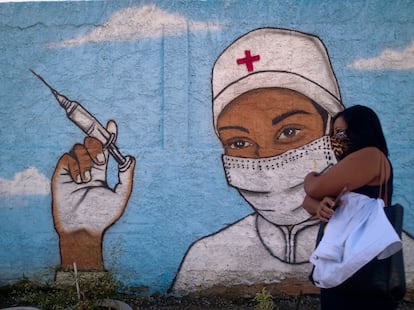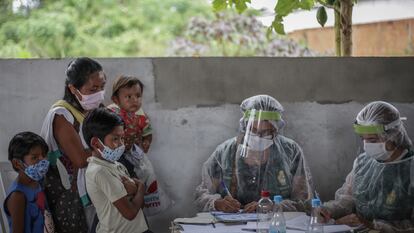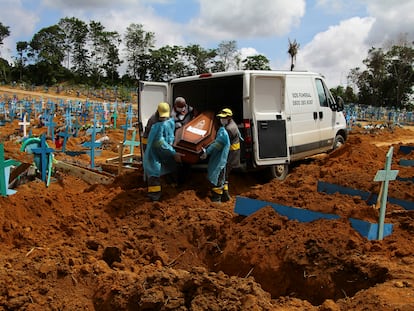How South America became a global leader in Covid-19 vaccination
Despite being one of the most unequal regions in the world, it has been able to immunize a high percentage of the population thanks to cultural factors, economic needs and wake-up calls


The news first broke in December: for the first time South America now led the world in terms of percentage of the population vaccinated – a position it still holds today. It hasn’t been easy: diplomatic and financial struggles to gain access to vaccines, high mortality rates, long lockdowns and political polarization made this position once seem highly unlikely. But as of January 5, according to statistics from the Our World in Data website, South America had vaccinated 76% of its people with at least one dose, and 64% of inhabitants are fully vaccinated, just above Europe (66% and 62%) and the United States (74% and 62%). This is all despite South America’s much tougher fight to access vaccines in the first place.
What happened in a region that is also home to the country with the highest number of deaths per capita due to the pandemic (Peru) and the second-highest number of total deaths (Brazil)? The question contains a partial answer: fear of the havoc that the coronavirus has wreaked in the region was more powerful than any anti-vaccine conspiracy. However, this does not show the full picture of the progress of vaccine campaigns in societies that have had to overcome economic, geographical and structural obstacles to reach the arms of their citizens.
South America’s vaccine success story is multi-factored and varies from country to country, but it is also possible to trace common factors, especially historical ones. These include a deep-rooted culture of vaccination, and respect for health systems that still serve the public however fragile and weakened they became during the pandemic. This same health infrastructure was revived in order to drive vaccination campaigns in economies with very high rates of informal, precarious labor. High existing uptake of vaccinations therefore combined with a basic need to go out and earn money to survive, leading major powers in the region to achieve very high percentages of vaccinated citizens.
Brazil: extraordinary achievements despite vaccine-skeptic president
The percentage of Brazilians vaccinated against Covid exceeds the world and regional average. It’s an extraordinary achievement for South America’s most populous country, which is also led by one of the few heads of state who has openly rejected vaccination and has spread misinformation about vaccines. According to Our World in Data, 67% of Brazil’s 210 million people are fully vaccinated and another 11% have received the first dose.
Firstly, this is down to the extensive network of the Brazilian public health system, which reaches every corner of the country. Secondly, once the initial problems in purchasing vaccines were solved and the supply started flowing properly in July, this system showed its strength. Sometimes two million doses were administered on a single day in Brazil. Thirdly, this was easy to access: there were a wide range of sites to receive the jab, with long opening hours. In addition, the fear of omicron has shortened the time required for a booster dose.

Covid has killed more than 600,000 people in Brazil, weakening Bolsonaro’s provocative criticisms of vaccination and claims the virus was little worse than the common cold. Confidence in vaccines and the public health system remained steady. Vaccination campaigns in Brazil even have their own mascot, Zé Gotinha, whose presence stretches back decades. Meanwhile Brazil’s economic elite forced the federal government to embrace vaccination (albeit reluctantly) when it publicly warned that it was essential to reactivate the economy. Teenagers have got vaccinated enthusiastically, doing whatever it takes to revive the most awaited party of the year, Brazil’s Carnival.
Argentina: tradition and Sputnik
Argentina has administered almost 78 million vaccines against the coronavirus, the second-highest number in South America after Brazil. Eighty-four percent of the population has received at least one dose, 72.9% has had two and 14% has already received a third booster shot. Anti-vaccine movements are a minority in the country and are not well organized, though the government has had a hard time reaching the 16% of people who have not yet been inoculated. High uptake is linked to an ingrained health culture. Babies receive their first vaccination minutes after birth, and when they grow up, they cannot enter the education system if they do not present documentation showing they have received mandatory shots. “We have one of the most comprehensive vaccination schedules in Latin America,” explains an Argentine government source. “Vaccination is something that the population has culturally ingrained. In addition to that, the H1N1 virus also served as an experience in introducing something out of the ordinary into the normal vaccination schedule,” the source added.
Securing enough doses was an uphill battle in Argentina. Months after the start of the pandemic, the country celebrated the agreement with AstraZeneca to produce millions of doses with Mexico as a great triumph. But things did not turn out as expected, and when it was already evident that the contract could not be fulfilled (Mexico argued that it could not obtain the necessary supplies in the open market), Argentina opted for the Russian vaccine Sputnik V. It became one of the first countries to approve its use, which allowed it to start the rollout in December 2020. Alberto Fernández’s government received harsh criticism from the conservative opposition, which accused it of declining to purchase from US-funded pharmaceutical companies such as Pfizer for ideological reasons. One year on, there is no shortage of vaccines in the country. The Health Ministry now stocks 17 million doses from six different pharma companies.
Chile: success of public/private partnership
Chile quickly took a regional and global lead on vaccination against Covid-19. President Sebastián Piñera, who leaves office in March, has announced that he will start a new booster campaign with a fourth dose, initially focused on the immunocompromised. Infections are increasing in the middle or the southern hemisphere summer, and the Health Ministry wants to maintain the immunity of the population against the virus in a place where the omicron variant does not yet predominate.
As of today, 92.2% of the population entitled to Covid-19 vaccines have received them. At the center of this success is a robust primary health system that was set up in the 1950s and which prevailed even through the dictatorship of Augusto Pinochet. Chile has complex geography and terrain, but clinics can be found even in the most remote places. Similarly to other Southern American countries mentioned, there is a strong culture of vaccination from an early age. Chile has had one of the most open economies in the world since the 1990s, with strong international trading links that have facilitated negotiations to obtain vaccines early on. So far, almost 50 million doses have arrived in the country, mainly from Sinovac and Pfizer-BioNTech, but the government also has agreements signed and contracts with AstraZeneca, CanSino (Saval), Johnson & Johnson, and the Russian vaccine Sputnik V, the latter of which was approved in Chile for people aged 18 and over.
The collaboration of the public and private health systems has also been crucial, with both sectors providing a united front to face the disease. The collaboration of universities and the negotiating skills of President Piñera himself, who has a recognized talent for business, are other elements that explain Chile’s success in obtaining vaccines and its successful vaccination rollout.
Colombia: from stuttering start to vaccine take-off
Although Colombia fell short of its goal of immunizing 70% of the population of 50 million with two doses by the end of 2021, it closed the year with 75.4% of the population vaccinated with the first dose, 55.7% fully vaccinated and 6.5% with a booster dose, according to Our World in Data. The country had a solid vaccination record, with no major anti-vaxxer movements, and one of the largest programs in the region providing free access to 21 vaccines that protect against 26 diseases.
In March, Colombia also became the first country in Latin America, and one of the first in the world, to receive vaccines through the Covax mechanism led by the World Health Organization (WHO). This Monday it was announced that the Spanish government will donate a new batch of almost 5.5 million doses through Covax in the coming weeks, placing Spain as the top international donor of vaccines to Colombia (followed by the United States). This is a reflection of the multi-pronged approach approved by Bogota. The government chose to combine this multilateral strategy with several bilateral negotiations with pharmaceutical companies. Separately, private companies also acquired and administered two million doses for employees and family members.
“Having a diversified portfolio was key, so the population has received five vaccines [Pfizer, Sinovac, AstraZeneca, Janssen and Moderna] and when one of them has been in short supply, another one has arrived to supply the demand,” says Carlos Dáguer, author of several books on public health. When the pace began to slow, the government decided to demand proof of vaccination to enter restaurants and entertainment venues, and to extend vaccination to those aged three years and older. “Asking for the vaccination passport in places of entertainment has allowed us to grow in a very important way among young people,” said Health Minister Fernando Ruiz in December.
Peru: better late than never
Peru received the first batch of Chinese vaccines (Sinopharm) on February 7, 2021. This was late compared to some neighboring countries, and initially these were destined for health personnel and the security forces. Francisco Sagasti’s government ended in July 2021 with 18% of adults vaccinated, and with a change of government the new Castillo administration closed 2021 with 80% of the population over 12 years of age immunized.
Several factors explain why the majority attended vaccination centers in the second half of 2021, despite strong campaigns from anti-vaxxers. Peru was the country with the highest fatality rate in the world due to Covid-19, with almost 6,000 deaths per million inhabitants. It is also home to the highest number of children globally who were orphaned by the coronavirus. This repeated brush with death meant the population relied on vaccines rather than face the possibility of having to deal with a serious illness requiring oxygen in intensive care units (ICUs). They had every reason: in the first half of 2021, Peru suffered thousands of additional deaths due to a lack of ICU beds and lack of money to buy expensive oxygen from private companies, as it became scarce in the public health system.
Peru’s Ministry of Health also organized mass-vaccination events, vaccination parties, and sent vaccinators house-to-house in the remote communities of the Andes and the Amazon. The health authorities worked hard in these regions to alleviate anti-vaccine misinformation. Meanwhile the Peruvian economy fell 11% in the first year of the pandemic and informal employment went from 72% to 78%, meaning immunization could give some protection for those going out to work. In November 2021, the government made vaccination mandatory in companies with more than 10 workers, pushing thousands of stragglers to get vaccinated. When omicron loomed, the health authorities made it compulsory to show full proof of vaccination to enter shopping centers, restaurants and cinemas as of December 10.









































